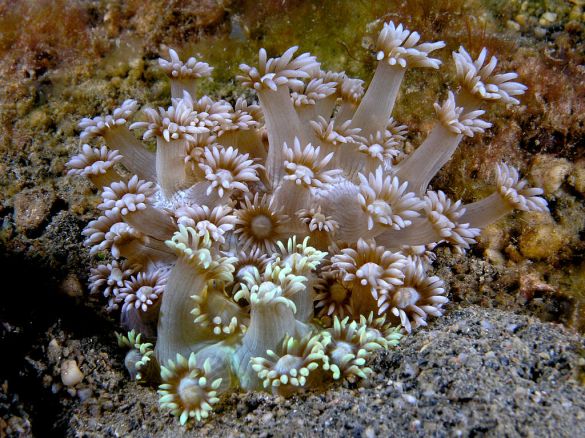When I was younger I remember vacationing in tropical places such as Mexico and the Dominican Republic and picking up stony rock material and asking my mom what it was. She replied saying “it is a piece of coral” (now, understood as a coral skeleton). I grew up only understanding what coral looked like from vacations and movies. However, I had no idea about the basics of coral, let alone if coral was a plant or animal. My intent for this post is to help people understand what coral is and some of the basic information that surrounds them. This background knowledge will help us understand the bigger picture of coral reefs.
What is a coral?
“A little bit algae, a little bit rock, and a lot animal.” Coral is a marine invertebrate that is composed of a simple structure known as a polyp. The polyp has one opening which is the coral’s mouth that is surrounded by a ring of tentacles. These tentacles have stinging cells called cnidocytes, used for food and protection. These cells fire tiny toxic barbs called nematocysts, when they are touched to ward off predators. Inside the polyp are reproductive and digestive tissues. Coral can live as an individual polyp, but many corals come together to create colonies.

“Coral Polyp” by Wikimedia Commons under CC by 2.0
Coral come in many different shapes and colors. These are not the only aspects that vary in coral. Their sex lives vary as well. Some species have distinct male or female polyps while other coral can alternate gender. For some coral that only have single-gender polyps certain events (ie. full moon) trigger the polyps to release massive amounts of sperm and eggs that flood into the seas. This results in many fertilized eggs that can become a polyp once they settle on a surface and begin to grow. Other species can even reproduce asexually, budding new polyps that grow either on an older polyp or drift around before landing on a new surface.
Types of Coral
When people think about coral they often think about the stony calcified coral they get at a gift shop during a vacation to a tropical island. However, these stony corals are only one type of coral. There are also deep water corals that live in dark water and soft corals.
-
Soft Corals
Soft Corals are often resemble plants and trees. They are soft and bendable so they do not have stony skeletons. For protection and support they grow wood-like cores for stability. This type of coral is referred to as ahermatypes (non-reef building corals).

“Goniopora djiboutiensis (Soft coral)” by Wikimedia Commons under CC by 2.0
-
Hard Corals
Hard Corals are the fundamental part of building the coral reef. Hard corals create skeletons out of calcium carbonate (limestone), that will eventually become rock. Since hard corals can build reefs they are known as hermatypes. These corals have a symbiotic relationship with tiny algae called zooxanthellae (pronounced zo-zan-THEL-ee).

“Chromis viridis on purple Acropora” by Brian Gratwicke under CC by 2.0
-
Deep Water Corals

Your mom was almost right about that chunk of stony, calcified stuff – but it isn’t all by itself a coral. It is sort of like coming across a tiny skeleton and calling it a mouse. That stony skeleton is very important, but only part of the whole animal when alive. The soft living tissue comprised of many interconnected polyps living on and within that skeleton (as you explain here) is often unknown to most people. Great job with describing the essentials!
LikeLiked by 2 people
very well written post!! You mentioned predators, I know parrot fish are known to be predators of some corals. Do you know other fish or organisms that can be a threat to corals?
LikeLiked by 2 people
Audrey, I have read a lot of articles about crown-of-thorn sea stars which seem to be the major threat. If you check out my twitter feed you can see an article I posted about the threat of sea stars. It talks about how we as humans are trying to spend all this time and resources to saving the corals but the sea stars are reversing the affects. Great question!
LikeLike
O good to know! thanks for the resources ill check that out!
LikeLiked by 1 person
Here is the article: http://www.futurity.org/coral-reefs-sea-stars-1355702-2/
LikeLiked by 1 person
The pictures you found were amazing! Very informative blog post with good hyperlinking. Goodjob!
LikeLiked by 1 person
Thanks!
LikeLike
Job well done with a lot of good information!
LikeLike
Thanks! Let me know if you think I should add anything or any critiques. Would love to hear from people. Always trying to improve it.
LikeLike